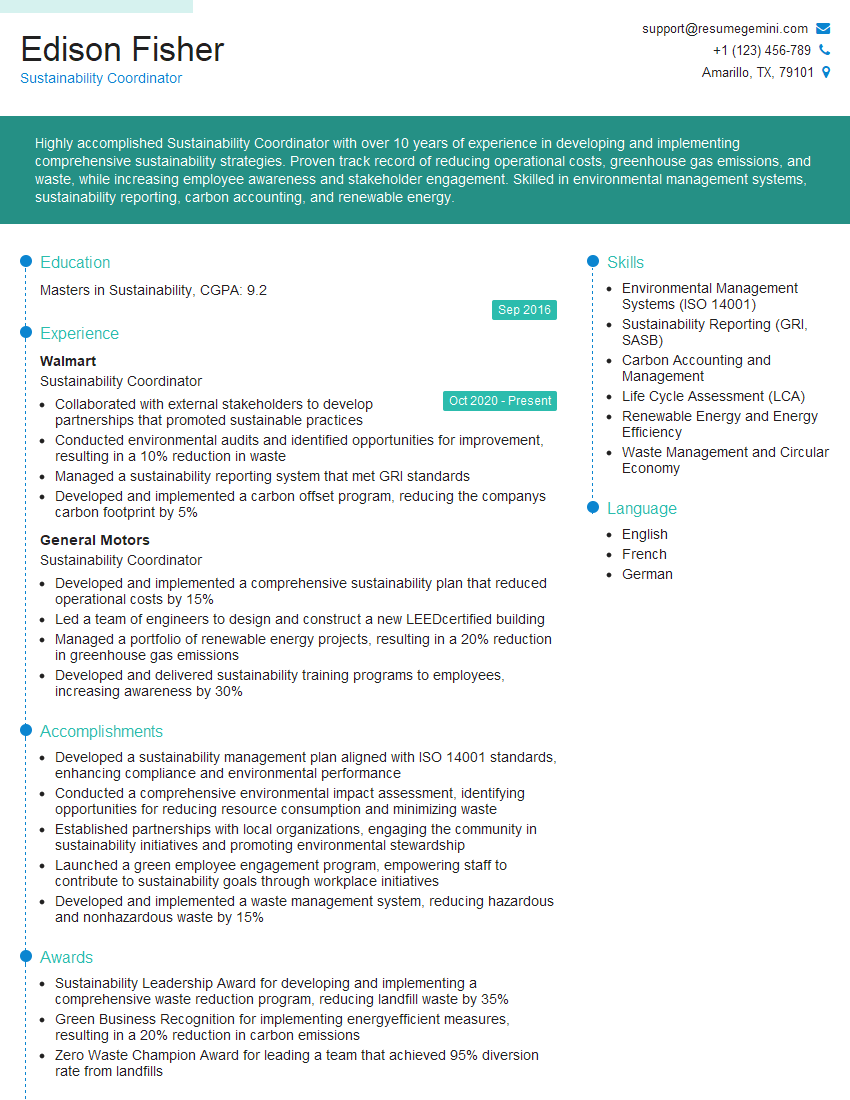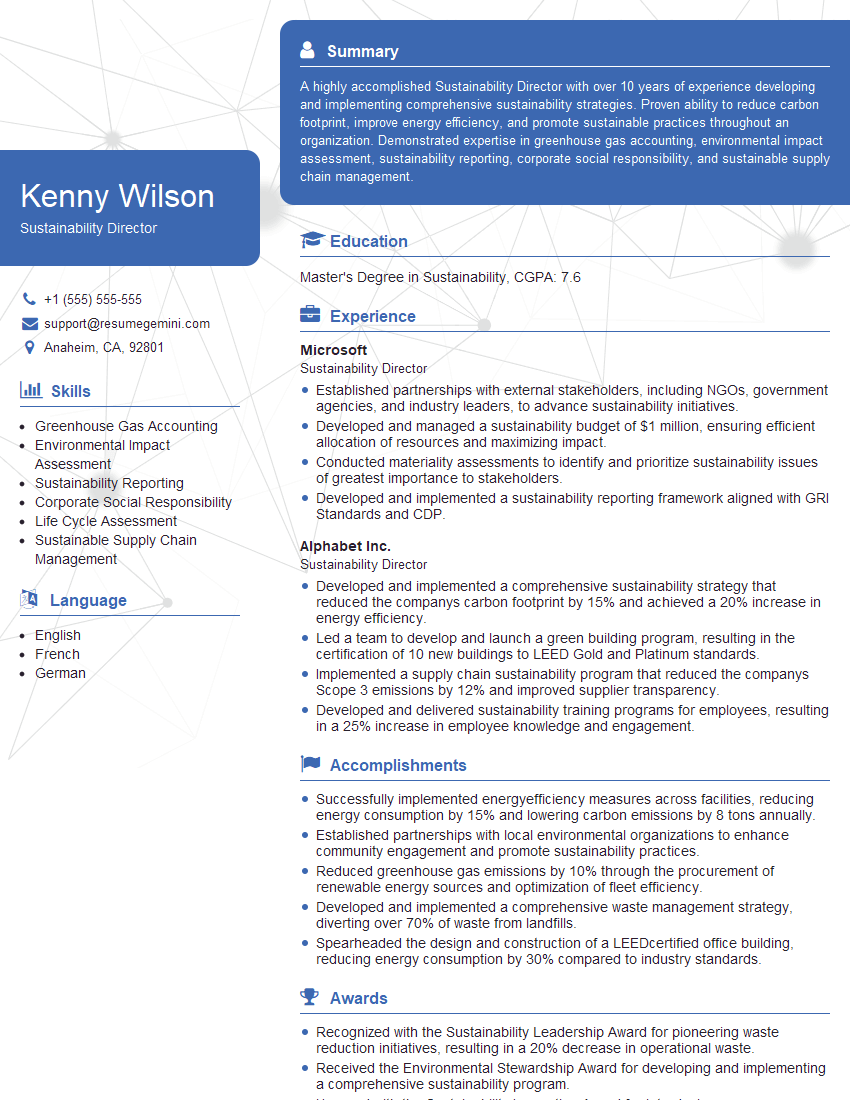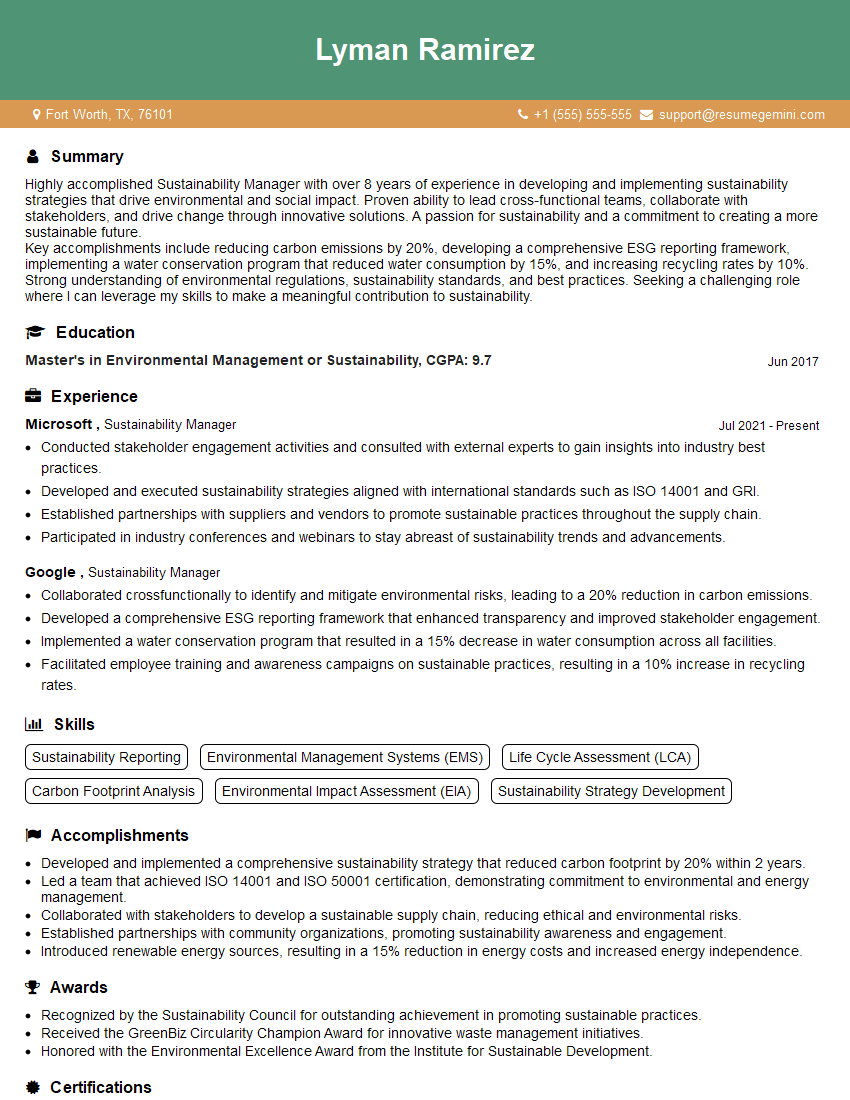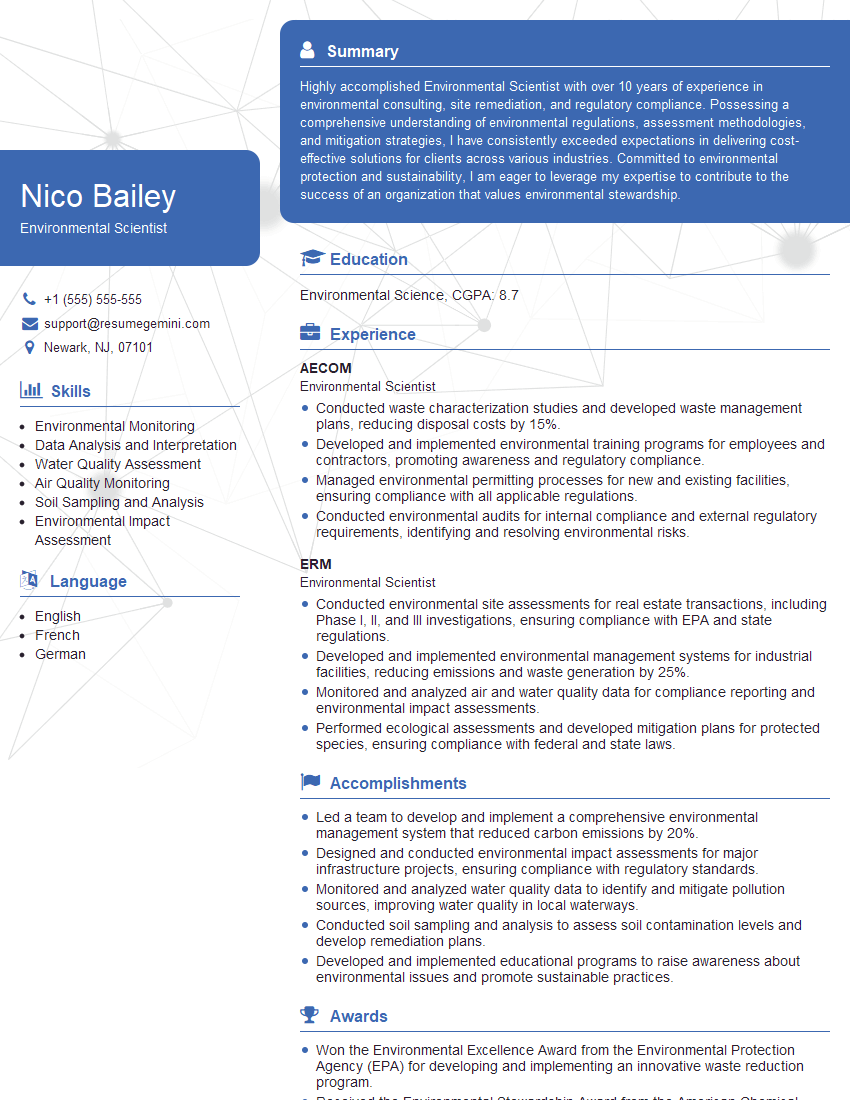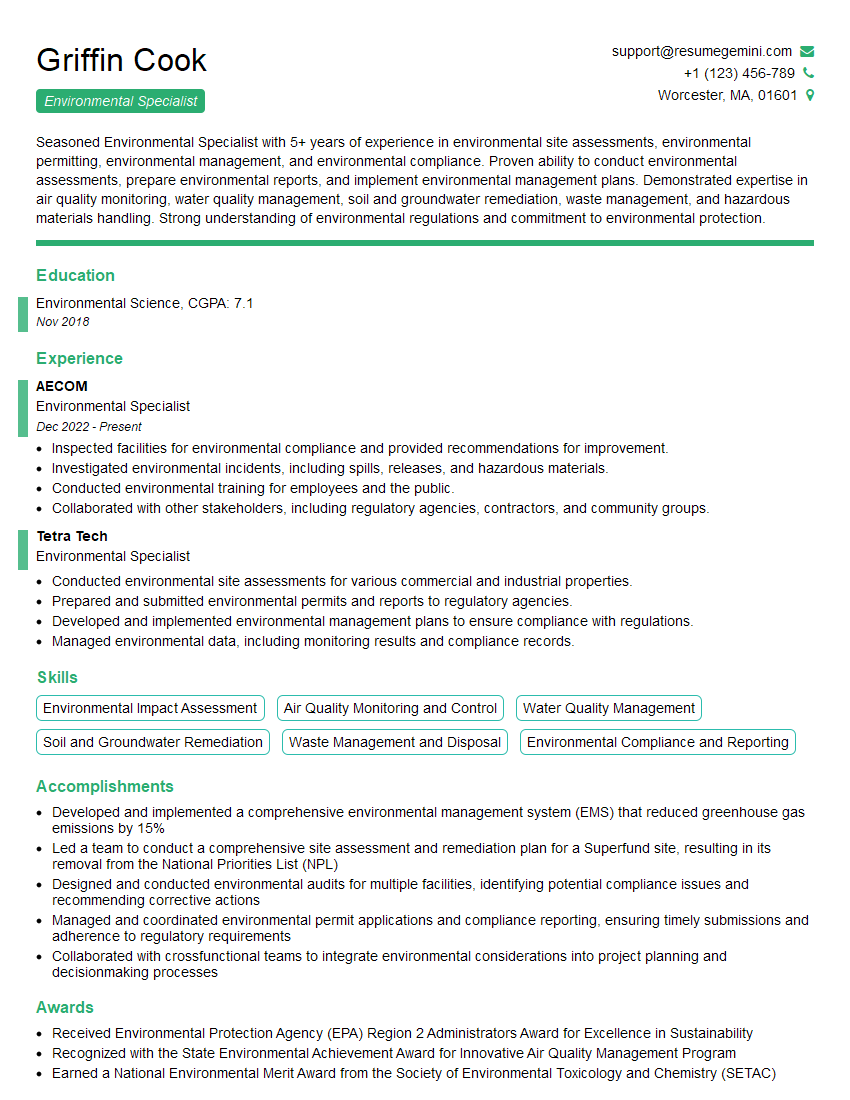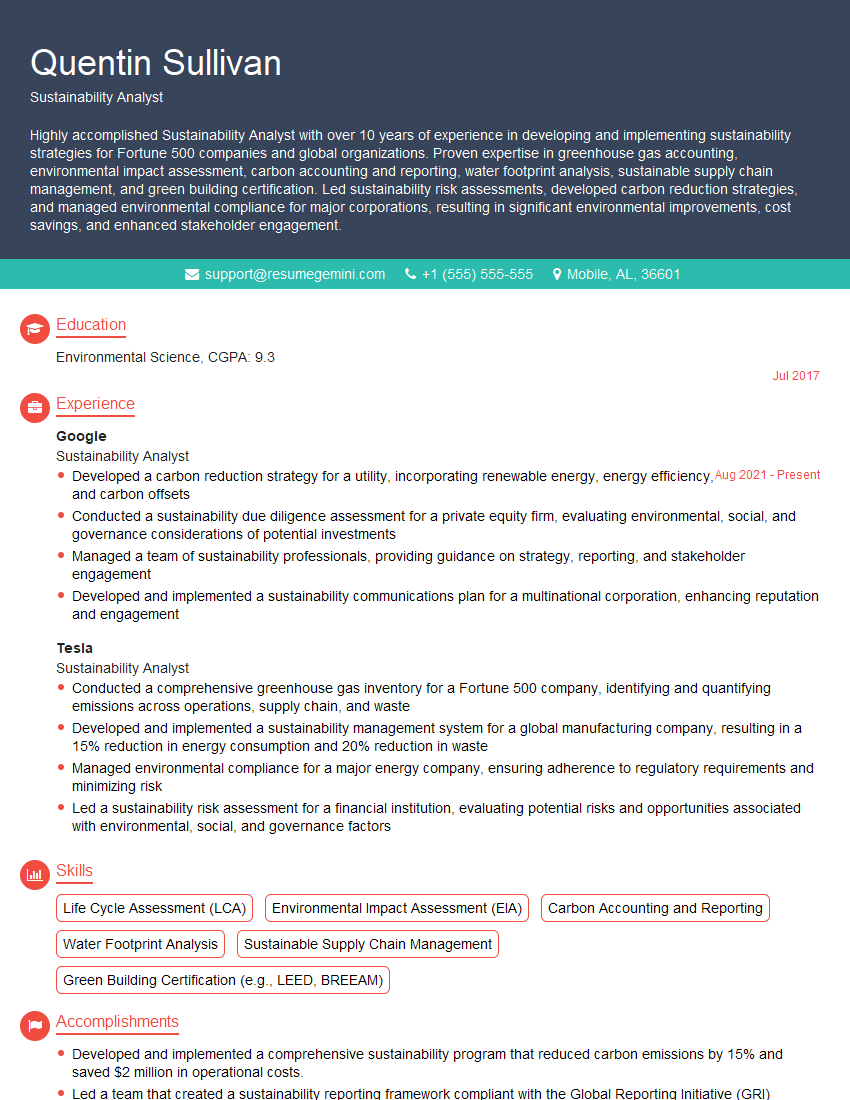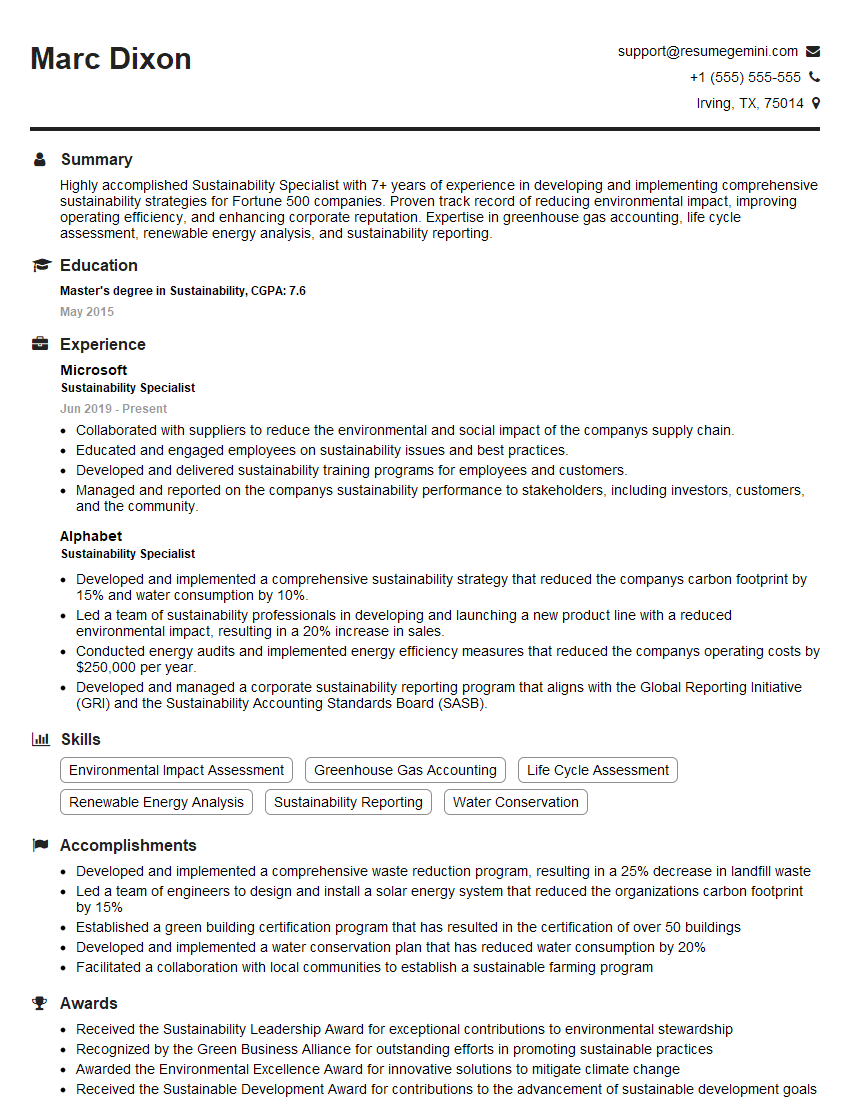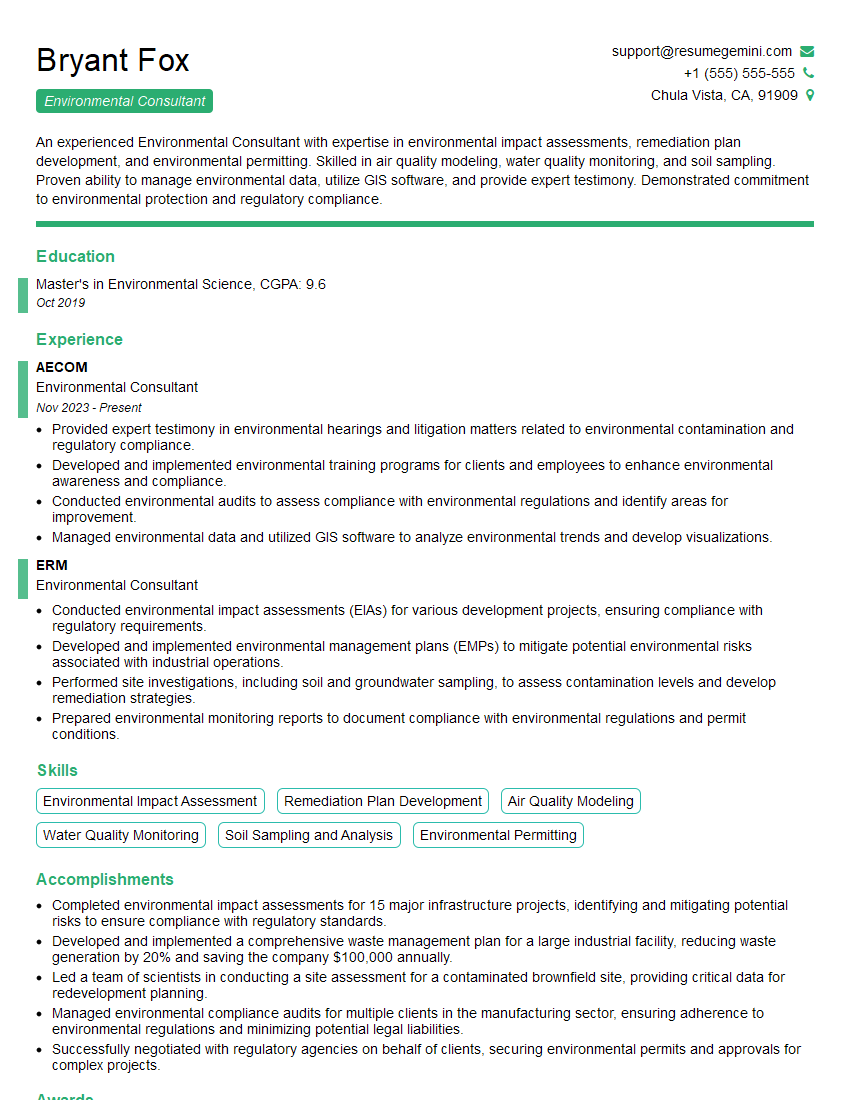Are you ready to stand out in your next interview? Understanding and preparing for Sustainable interview questions is a game-changer. In this blog, we’ve compiled key questions and expert advice to help you showcase your skills with confidence and precision. Let’s get started on your journey to acing the interview.
Questions Asked in Sustainable Interview
Q 1. Describe your experience with Life Cycle Assessment (LCA).
Life Cycle Assessment (LCA) is a comprehensive methodology used to evaluate the environmental impacts associated with all stages of a product or service’s life, from raw material extraction to disposal or recycling. Think of it as a cradle-to-grave analysis.
My experience with LCA includes conducting numerous assessments for various products, ranging from packaging materials to electronic devices. I’ve used software like SimaPro and GaBi to model complex supply chains and quantify impacts across various environmental categories like greenhouse gas emissions, water usage, and resource depletion. For example, in one project, we used LCA to compare the environmental performance of a plastic bottle versus a glass bottle, considering factors like manufacturing energy, transportation, and end-of-life management. This allowed our client to make an informed decision about sustainable packaging options, ultimately reducing their environmental footprint.
I’m proficient in all phases of LCA, including goal and scope definition, inventory analysis, impact assessment, and interpretation. I understand the limitations of LCA and the importance of data quality and transparency.
Q 2. Explain the concept of carbon footprint and its calculation methods.
A carbon footprint represents the total amount of greenhouse gases (GHGs) – primarily carbon dioxide (CO2), but also methane (CH4), nitrous oxide (N2O), and others – generated by our actions. It’s a measure of our contribution to climate change.
Calculating a carbon footprint involves identifying all GHG emissions associated with a specific activity, product, or organization. This usually involves a combination of approaches:
- Direct emissions (Scope 1): These are emissions from sources directly owned or controlled by the organization, such as fuel combustion in company vehicles.
- Indirect emissions from energy consumption (Scope 2): These are emissions from the generation of purchased electricity, heat, or steam consumed by the organization.
- Other indirect emissions (Scope 3): These are all other indirect emissions in the organization’s value chain, which are often the most challenging to quantify. Examples include emissions from transportation of goods, purchased goods and services, employee commuting, waste disposal, and business travel.
Calculation methods vary depending on the scope and complexity of the assessment. They often involve using emission factors (e.g., grams of CO2 equivalent per kilowatt-hour of electricity) from established databases like IPCC guidelines or national inventories. Software tools and consultants are commonly used to streamline and enhance accuracy in complex scenarios.
For instance, I recently assisted a company in calculating their Scope 1 and 2 emissions as a baseline for setting GHG reduction targets. This involved collecting energy consumption data, vehicle fuel use information, and applying relevant emission factors.
Q 3. How familiar are you with ISO 14001 environmental management systems?
I am very familiar with ISO 14001, the internationally recognized standard for Environmental Management Systems (EMS). It provides a framework for organizations to systematically manage their environmental responsibilities.
My understanding encompasses the key elements of the standard, including:
- Environmental policy: Defining the organization’s commitment to environmental performance.
- Planning: Identifying environmental aspects and impacts, setting objectives and targets, and developing programs to achieve them.
- Implementation and operation: Establishing processes and procedures to manage environmental aspects and meet objectives.
- Checking and corrective action: Monitoring and measuring environmental performance, identifying deviations, and taking corrective action.
- Management review: Regularly reviewing the EMS’s effectiveness and making necessary improvements.
I’ve helped several organizations implement and maintain ISO 14001 certification, guiding them through the process of documentation, internal audits, and management reviews. This includes developing environmental management plans, conducting environmental impact assessments, and training staff on environmental responsibilities. I’ve seen firsthand how ISO 14001 can improve environmental performance, reduce costs, and enhance an organization’s reputation.
Q 4. What are the key principles of sustainable development?
The key principles of sustainable development, as defined by the Brundtland Report (Our Common Future), are often summarized as meeting the needs of the present without compromising the ability of future generations to meet their own needs. This encompasses three interconnected pillars:
- Environmental sustainability: Protecting and conserving natural resources, reducing pollution, and mitigating climate change.
- Economic sustainability: Ensuring economic growth and prosperity while maintaining environmental integrity and social equity. This focuses on responsible resource management and innovation.
- Social sustainability: Promoting social equity, justice, and well-being, including access to education, healthcare, and decent work. This considers the needs and rights of all people.
These principles are interdependent and require a holistic approach. For example, investing in renewable energy technologies (environmental) can create jobs and stimulate economic growth (economic) while improving air quality and public health (social).
Q 5. Describe your understanding of circular economy principles.
The circular economy is a model that aims to minimize waste and maximize the use of resources by keeping materials in use for as long as possible. This contrasts with the traditional linear economy (take-make-dispose) by emphasizing:
- Reduce: Minimizing resource consumption and waste generation.
- Reuse: Extending the lifespan of products through repair, refurbishment, or repurposing.
- Recycle: Recovering materials from waste and using them to create new products.
- Recover: Extracting energy or other valuable materials from waste.
Imagine a closed loop system where products are designed for durability, repairability, and recyclability. This involves innovative business models like product-as-a-service, where companies retain ownership of products and are incentivized to keep them functioning for longer. The principles of the circular economy are crucial for mitigating environmental impacts and building a more resilient and sustainable society.
For example, in the textile industry, a circular economy approach could involve using recycled materials, designing clothes for durability and easy repair, and implementing clothing rental services to reduce consumption.
Q 6. How would you measure the success of a sustainability initiative?
Measuring the success of a sustainability initiative requires a multi-faceted approach, using both qualitative and quantitative indicators. Key aspects include:
- Environmental impact reduction: Tracking changes in GHG emissions, water consumption, waste generation, or resource depletion. This might involve comparing baseline data with post-implementation data.
- Economic performance: Assessing the financial benefits of the initiative, such as cost savings from energy efficiency improvements or increased revenue from sustainable products.
- Social impact: Measuring the initiative’s effect on communities, employee well-being, or stakeholder satisfaction. This could include surveys, interviews, or focus groups.
- Compliance: Monitoring adherence to environmental regulations and standards.
- Stakeholder engagement: Assessing the level of participation and satisfaction among stakeholders involved in the initiative.
Choosing the right metrics depends on the specific initiative and its goals. It’s crucial to establish clear baselines, track progress regularly, and adapt strategies based on the results. For instance, if a company implements a recycling program, success could be measured by the amount of waste diverted from landfills, employee participation rates, and cost savings from reduced waste disposal fees.
Q 7. Explain your experience with stakeholder engagement in sustainability projects.
Stakeholder engagement is crucial for successful sustainability projects. My experience involves actively involving diverse stakeholders – including employees, customers, suppliers, local communities, investors, and regulators – throughout the project lifecycle.
I’ve used a variety of engagement methods, such as:
- Surveys and questionnaires: Gathering input on stakeholder priorities and preferences.
- Workshops and focus groups: Facilitating collaborative discussions and idea generation.
- One-on-one meetings: Building relationships and addressing specific concerns.
- Public forums and presentations: Communicating project progress and receiving feedback.
- Transparent reporting and communication: Regularly providing updates and demonstrating accountability.
In a recent project involving a community solar initiative, we engaged local residents through public meetings, addressing their concerns about land use and visual impacts. This transparent communication helped build support for the project and ensured its success. Effective stakeholder engagement ensures project legitimacy, buy-in, and helps address potential conflicts early on, leading to better outcomes and broader acceptance of sustainability initiatives.
Q 8. What are the major environmental challenges facing businesses today?
Businesses today face a multitude of interconnected environmental challenges. These can be broadly categorized into resource depletion, pollution, and climate change.
- Resource Depletion: This includes the over-extraction of raw materials like timber, minerals, and water, leading to deforestation, biodiversity loss, and water scarcity. For example, a clothing company sourcing cotton might contribute to water stress in regions with intensive cotton farming.
- Pollution: This encompasses air, water, and soil pollution from manufacturing processes, waste disposal, and transportation. A manufacturing plant releasing untreated wastewater into a river is a clear example of water pollution. The resulting damage impacts not only the environment but also public health and potentially the company’s reputation.
- Climate Change: This is arguably the most pressing challenge, encompassing greenhouse gas emissions from energy consumption, transportation, and industrial processes. The resulting effects, like rising sea levels, extreme weather events, and disruptions to supply chains, impact nearly every industry.
Addressing these challenges isn’t just an ethical imperative; it’s becoming increasingly crucial for business survival and long-term profitability. Consumers are demanding greater transparency and accountability, and stricter regulations are continually being implemented.
Q 9. How familiar are you with different sustainability reporting frameworks (e.g., GRI, SASB)?
I’m very familiar with various sustainability reporting frameworks. The Global Reporting Initiative (GRI) is a widely used standard providing a comprehensive framework for organizations to report on their economic, environmental, and social performance. It’s known for its breadth and detailed metrics. The Sustainability Accounting Standards Board (SASB) focuses on financially material environmental, social, and governance (ESG) issues that are likely to affect a company’s value. SASB offers industry-specific standards, making it more tailored to the specific risks and opportunities of different sectors.
Other frameworks I’m familiar with include the Carbon Disclosure Project (CDP), which focuses specifically on climate change, and the Integrated Reporting Framework (IR), which integrates financial and sustainability reporting. The choice of framework depends on the organization’s size, industry, and specific reporting needs. For example, a publicly traded company might favor SASB for its investor-centric focus, while a smaller, family-owned business might opt for GRI’s broader approach.
Q 10. Describe your experience with renewable energy technologies.
My experience with renewable energy technologies spans various applications. I’ve worked on projects involving the integration of solar photovoltaic (PV) systems in commercial buildings, optimizing their energy yield through site assessments and system design. I’ve also been involved in evaluating the feasibility of wind energy projects, considering factors such as wind resource assessment, grid connection, and environmental impact.
Furthermore, I’ve conducted research on the efficiency and economic viability of different renewable energy technologies, including biomass energy and geothermal energy. For instance, I helped a manufacturing facility switch from grid electricity to on-site solar power, resulting in significant cost savings and a substantial reduction in their carbon footprint. This involved not just the technical installation but also securing financing and navigating regulatory hurdles.
Q 11. How would you approach reducing waste in a manufacturing process?
Reducing waste in a manufacturing process requires a systematic approach focusing on the entire lifecycle of the product, from design to disposal.
- Design for Manufacturing (DFM): Optimizing product design to minimize material usage and waste generation is critical. This could involve using modular designs, employing recycled materials, and designing for easy disassembly and recyclability.
- Lean Manufacturing Principles: Implementing lean manufacturing principles, such as eliminating non-value-added activities and identifying bottlenecks, can drastically reduce waste. Techniques like Kaizen (continuous improvement) and 5S (sort, set in order, shine, standardize, sustain) are valuable tools.
- Waste Segregation and Recycling: Implementing effective waste segregation systems helps improve recycling rates and enables the recovery of valuable materials. This could involve investing in waste sorting equipment and partnering with recycling facilities.
- Process Optimization: Analyzing the manufacturing process to identify and eliminate sources of waste, such as defects, overproduction, and waiting time. This could involve using data analytics to track and optimize production efficiency.
For example, I worked with a food processing plant to reduce packaging waste by 30% by switching to recyclable materials and optimizing packaging size. This involved close collaboration with their supply chain partners and marketing team.
Q 12. What is your experience with sustainable supply chain management?
My experience in sustainable supply chain management centers on enhancing transparency, traceability, and efficiency while minimizing environmental and social impacts throughout the entire supply chain.
I’ve worked on projects involving mapping supply chains to identify environmental and social risks, developing supplier codes of conduct, and implementing monitoring systems to track compliance. For instance, I helped a tech company assess the environmental impact of its electronics manufacturing supply chain, identifying hotspots of greenhouse gas emissions and resource consumption. We then collaborated with suppliers to implement improvements, leading to a significant reduction in their overall carbon footprint.
This involved establishing clear communication channels, providing training and support to suppliers, and using technology like blockchain to improve transparency and traceability of materials.
Q 13. Explain your understanding of climate change mitigation and adaptation strategies.
Climate change mitigation focuses on reducing greenhouse gas emissions to slow down or prevent global warming. This involves transitioning to renewable energy sources, improving energy efficiency, implementing carbon capture and storage technologies, and promoting sustainable land use practices.
Climate change adaptation focuses on adjusting to the effects of climate change that are already happening or are expected in the future. This includes developing drought-resistant crops, building seawalls to protect coastal communities, and improving water management systems.
An example of a mitigation strategy is investing in large-scale renewable energy projects like solar farms or wind turbines. An example of an adaptation strategy might be developing early warning systems for extreme weather events or implementing flood control measures. Many strategies require a combined approach – for example, investing in sustainable agriculture both reduces emissions (mitigation) and enhances resilience to changing climate patterns (adaptation).
Q 14. How would you implement a sustainable procurement policy?
Implementing a sustainable procurement policy requires a multi-stage approach:
- Define Sustainability Criteria: Establish clear criteria for evaluating suppliers based on environmental and social performance. This might include factors like carbon emissions, waste generation, water usage, ethical labor practices, and compliance with relevant regulations.
- Supplier Assessment and Selection: Develop a robust supplier assessment process to evaluate their sustainability performance against the defined criteria. This might involve using questionnaires, audits, or third-party certifications.
- Contractual Agreements: Incorporate sustainability clauses into procurement contracts, holding suppliers accountable for meeting agreed-upon targets.
- Monitoring and Reporting: Establish a system for monitoring supplier performance and reporting on progress toward sustainability goals. This could involve regular data collection, analysis, and reporting to relevant stakeholders.
- Continuous Improvement: Regularly review and update the sustainable procurement policy to reflect evolving best practices and industry standards.
For instance, a company might require all suppliers to disclose their carbon footprint and demonstrate compliance with environmental regulations. This ensures that the company’s procurement decisions contribute positively to its overall sustainability objectives.
Q 15. Describe your experience with environmental impact assessments.
Environmental Impact Assessments (EIAs) are crucial tools for evaluating the potential environmental consequences of proposed projects, policies, or programs. My experience encompasses conducting EIAs across various sectors, from infrastructure development (like highway construction) to industrial projects (such as a new manufacturing plant). This involves a multi-stage process:
- Scoping: Identifying potential environmental impacts based on the project’s nature and location.
- Baseline data collection: Gathering information on existing environmental conditions (air and water quality, biodiversity, etc.).
- Impact prediction: Using models and expert judgment to predict the magnitude and significance of potential impacts.
- Mitigation measures: Developing strategies to avoid, minimize, or offset negative impacts. For instance, in a highway project, this might involve implementing noise barriers or creating wildlife crossings.
- Reporting and review: Documenting findings, mitigation strategies, and conclusions in a comprehensive report for regulatory review.
For example, in a recent EIA for a wind farm project, we carefully assessed the potential impact on bird populations through detailed ornithological surveys and modeled the project’s visual impact on the surrounding landscape. This resulted in adjustments to the turbine placement and operational strategies to minimize harm to birds and maintain visual amenity.
Career Expert Tips:
- Ace those interviews! Prepare effectively by reviewing the Top 50 Most Common Interview Questions on ResumeGemini.
- Navigate your job search with confidence! Explore a wide range of Career Tips on ResumeGemini. Learn about common challenges and recommendations to overcome them.
- Craft the perfect resume! Master the Art of Resume Writing with ResumeGemini’s guide. Showcase your unique qualifications and achievements effectively.
- Don’t miss out on holiday savings! Build your dream resume with ResumeGemini’s ATS optimized templates.
Q 16. What are some key indicators of environmental performance?
Key indicators of environmental performance vary depending on the specific organization and industry, but some common ones include:
- Greenhouse gas (GHG) emissions (e.g., tons of CO2e): A crucial indicator of climate change impact, often broken down by scope 1, 2, and 3 emissions.
- Energy consumption (e.g., kWh): Reflecting energy efficiency and reliance on renewable sources.
- Water consumption (e.g., liters): Assessing water usage efficiency and potential water stress.
- Waste generation (e.g., tons): Measuring waste reduction efforts and the amount of waste sent to landfills versus recycling/composting.
- Biodiversity indicators (e.g., species richness, habitat area): Evaluating the impact on local ecosystems.
- Air emissions (e.g., tons of pollutants): Monitoring the release of harmful substances into the atmosphere.
These indicators can be tracked using various metrics, such as intensity metrics (e.g., emissions per unit of production), allowing for comparisons over time and across different organizations.
Q 17. How familiar are you with environmental regulations (e.g., EPA regulations)?
I am very familiar with a wide range of environmental regulations, including those issued by the Environmental Protection Agency (EPA) in the US and equivalent agencies globally. My understanding encompasses various legislation related to air and water quality, waste management, hazardous materials handling, and endangered species protection. For example, I’m proficient in interpreting and applying regulations such as the Clean Air Act, the Clean Water Act, and the Resource Conservation and Recovery Act (RCRA).
Understanding these regulations is critical for ensuring compliance and mitigating environmental risks. My experience includes conducting compliance audits, developing environmental management systems (EMS) aligned with ISO 14001 standards, and advising companies on best practices for regulatory compliance. I also stay abreast of emerging regulations and policy changes through professional networks and publications.
Q 18. How would you develop and implement a company’s sustainability strategy?
Developing and implementing a company’s sustainability strategy requires a structured approach:
- Materiality assessment: Identifying the environmental and social issues most relevant to the company’s business and stakeholders.
- Baseline assessment: Measuring the company’s current environmental performance using key indicators.
- Setting targets and goals: Establishing ambitious yet achievable targets aligned with scientific consensus (e.g., science-based targets for emissions reduction). This might involve reducing carbon emissions by 50% by 2030.
- Developing action plans: Outlining specific initiatives and responsibilities to achieve the targets. This could range from energy efficiency upgrades to sustainable supply chain management.
- Implementation and monitoring: Putting the action plans into effect and regularly monitoring progress against the targets.
- Reporting and communication: Transparent reporting on progress to stakeholders, including investors, customers, and employees.
For instance, I helped a manufacturing company implement a circular economy model, focusing on waste reduction, material reuse, and product lifecycle management. This resulted in significant cost savings and enhanced their brand reputation.
Q 19. Describe your experience with data analysis related to sustainability performance.
My experience with data analysis in sustainability includes using various tools and techniques to analyze environmental performance data. This often involves:
- Data collection and cleaning: Gathering data from diverse sources (e.g., energy meters, waste management systems, supply chain data) and ensuring data accuracy and consistency.
- Data analysis: Using statistical software (e.g., R, Python) and visualization tools (e.g., Tableau) to identify trends, patterns, and areas for improvement. This often involves calculating key performance indicators (KPIs) and performing trend analyses.
- Developing dashboards and reports: Creating interactive dashboards to monitor progress and communicate findings to stakeholders.
Example: A dashboard showing GHG emissions over time, broken down by source, with targets overlaid. - Life cycle assessment (LCA): Analyzing the environmental impacts of products or services throughout their entire lifecycle.
In one project, I used data analytics to identify the biggest contributors to a client’s carbon footprint and recommended targeted interventions that resulted in a 15% reduction in emissions within a year.
Q 20. How would you communicate sustainability performance to stakeholders?
Communicating sustainability performance effectively requires a multi-faceted approach tailored to different stakeholders:
- Investors: Focus on financial implications of sustainability initiatives, such as risk mitigation and return on investment (ROI). Use concise reports and presentations with key financial metrics.
- Customers: Emphasize the environmental benefits of products or services, using clear and simple language. Highlight certifications and sustainability achievements.
- Employees: Engage employees through internal communications, training programs, and opportunities for participation in sustainability initiatives. Celebrate successes and foster a culture of sustainability.
- Government and regulatory bodies: Ensure compliance with regulations and provide accurate and detailed reports as required.
Effective communication utilizes various channels, including sustainability reports, websites, social media, and presentations. It’s crucial to use clear, concise language, visually appealing graphics, and credible data to build trust and engagement.
Q 21. What are your thoughts on the role of technology in advancing sustainability?
Technology plays a transformative role in advancing sustainability. It empowers us to monitor, measure, and manage environmental impacts with unprecedented accuracy and efficiency. Some key examples include:
- IoT sensors and data analytics: Enabling real-time monitoring of energy consumption, water usage, and other key indicators, providing valuable insights for optimization.
- AI and machine learning: Optimizing energy grids, predicting environmental risks, and improving supply chain efficiency.
- Blockchain technology: Enhancing traceability and transparency in supply chains, combating deforestation and illegal activities.
- Remote sensing and GIS: Monitoring deforestation, land use change, and other environmental changes on a large scale.
- Renewable energy technologies: Driving the transition towards cleaner energy sources.
These technologies, when deployed strategically, can accelerate the transition towards a sustainable future. For example, the use of smart grids and renewable energy sources combined with AI-powered optimization can significantly reduce carbon emissions in the energy sector.
Q 22. How would you manage conflicts between sustainability goals and business objectives?
Balancing sustainability goals and business objectives requires a strategic approach that views sustainability not as a cost, but as an opportunity for innovation and long-term value creation. It’s about finding synergies, not trade-offs.
Identify Overlaps: Begin by identifying areas where sustainability initiatives directly support business objectives. For example, reducing energy consumption (sustainability) can lower operational costs (business). Investing in renewable energy can improve brand reputation and attract environmentally conscious customers.
Prioritization and Roadmap: Develop a prioritized roadmap that integrates sustainability targets into existing business plans. Use frameworks like the Materiality Matrix to assess which environmental and social issues are most relevant to the business and its stakeholders. This allows you to focus resources on initiatives with the highest impact.
Innovative Solutions: Embrace innovation to find creative solutions that address both challenges. For instance, a clothing company might switch to sustainable materials, not only reducing their environmental footprint but also attracting a new customer base that values ethical production.
Transparent Communication: Openly communicate the company’s sustainability strategy with employees, investors, and customers. Transparency builds trust and fosters buy-in, making it easier to navigate potential conflicts.
Metrics and Measurement: Track key performance indicators (KPIs) for both sustainability and business objectives. This allows for regular evaluation of the effectiveness of the integrated strategy and ensures accountability.
For example, in my previous role at a manufacturing company, we initially faced resistance to investing in energy-efficient equipment. By demonstrating a clear ROI through reduced energy bills and potential tax credits, we successfully secured funding and implemented the changes, exceeding both our sustainability and profitability targets.
Q 23. Describe your experience with developing and implementing sustainability training programs.
I have extensive experience developing and implementing sustainability training programs across various sectors. My approach is tailored to the specific needs and context of the organization and its employees. It’s crucial to make training engaging, practical, and relevant to daily work.
Needs Assessment: I begin with a thorough needs assessment to understand the existing knowledge base, identify skill gaps, and determine specific learning objectives. This ensures the program addresses the organization’s unique requirements.
Modular Design: I design modular training programs that can be delivered in various formats, including online modules, workshops, and on-the-job training. This flexibility caters to different learning styles and schedules.
Interactive Content: I incorporate interactive elements such as case studies, simulations, and group discussions to enhance engagement and knowledge retention. Gamification can also significantly boost participation and enjoyment.
Measurable Outcomes: Pre- and post-training assessments are crucial to measure the effectiveness of the program and identify areas for improvement. Tracking employee behaviour changes post-training is also important.
Ongoing Support: I believe that sustainability training is an ongoing process. Post-training support, such as mentoring programs or access to resources, is vital to maintain momentum and ensure lasting behavioral change.
In a previous project, I developed a comprehensive sustainability training program for a large retail chain. The program focused on waste reduction, energy efficiency, and ethical sourcing. Through pre- and post-training surveys and waste audits, we demonstrated a significant reduction in waste generation and increased employee awareness and engagement.
Q 24. How would you evaluate the effectiveness of a sustainability program?
Evaluating the effectiveness of a sustainability program requires a multi-faceted approach that goes beyond simply tracking quantitative data. It’s crucial to measure both the environmental and social impact, as well as the economic benefits.
Key Performance Indicators (KPIs): Define specific, measurable, achievable, relevant, and time-bound (SMART) KPIs aligned with program goals. Examples include energy consumption, waste reduction, water usage, greenhouse gas emissions, and social impact metrics such as employee satisfaction or community engagement.
Data Collection and Analysis: Implement robust data collection methods, such as automated metering, waste audits, and employee surveys. Regularly analyze the data to track progress and identify areas for improvement. Benchmarking against industry best practices can also provide valuable insights.
Stakeholder Engagement: Gather feedback from various stakeholders, including employees, customers, investors, and community members. This provides a holistic understanding of the program’s impact and identifies any unintended consequences.
Life Cycle Assessment (LCA): For certain initiatives, conducting an LCA can provide a comprehensive assessment of the environmental impacts of products or services throughout their entire life cycle, from raw material extraction to end-of-life disposal.
Return on Investment (ROI): Assess the financial benefits of the program, including cost savings, revenue generation, and increased efficiency. This helps demonstrate the business case for continued investment in sustainability initiatives.
For instance, when evaluating a recycling program, we would track the amount of waste diverted from landfills, the cost savings from reduced waste disposal fees, and employee satisfaction with the program’s implementation.
Q 25. What is your experience with carbon offsetting projects?
Carbon offsetting projects aim to compensate for greenhouse gas emissions by investing in activities that reduce or remove carbon dioxide from the atmosphere. My experience involves evaluating the credibility and effectiveness of such projects.
Project Verification: It’s crucial to ensure that offset projects are certified by reputable organizations, such as Gold Standard or Verra. This verifies the project’s environmental integrity and ensures that emissions reductions are accurately measured and reported.
Additionality: A critical aspect is ensuring that the project would not have happened without the investment from carbon offsetting. It should generate additional emissions reductions beyond what would have occurred otherwise.
Permanence: The reductions should be long-lasting and not easily reversed. For example, investing in reforestation projects needs to consider the long-term survival rate of the trees.
Project Type Evaluation: Different offset projects have varying levels of effectiveness and potential for leakage (where emissions are reduced in one area but increase elsewhere). A careful assessment is needed to choose projects with high environmental integrity.
Transparency and Traceability: The project should be transparent in its methodology, data reporting, and monitoring. It should be easy to trace the impact of the offset investment.
I’ve been involved in evaluating several reforestation projects in Latin America, focusing on their potential for carbon sequestration, biodiversity benefits, and community engagement. Rigorous verification and monitoring were crucial aspects of our evaluation.
Q 26. How familiar are you with sustainable finance and investment strategies?
Sustainable finance and investment strategies are rapidly evolving, focusing on integrating environmental, social, and governance (ESG) factors into investment decisions. I’m well-versed in various approaches.
ESG Investing: This involves considering ESG factors alongside financial returns when making investment choices. This can range from screening out companies with poor ESG performance to actively investing in companies with strong sustainability profiles.
Impact Investing: This aims to generate both financial returns and positive social and environmental impact. Impact investments often target specific sustainability challenges, such as renewable energy or sustainable agriculture.
Green Bonds: These are debt securities issued by governments or corporations to finance environmentally friendly projects, such as renewable energy infrastructure or energy efficiency improvements.
Sustainable Development Goals (SDGs): Many investment strategies are now aligned with the UN SDGs, providing a framework for targeting investments that contribute to a more sustainable future.
Materiality Assessment: Understanding which ESG factors are most material to a company’s long-term value creation is crucial for effective sustainable investment strategies.
In my experience, I’ve worked with investors to develop sustainable investment portfolios aligned with their ESG goals, utilizing data analytics and ESG ratings to identify promising investment opportunities.
Q 27. Explain your understanding of biodiversity conservation and its relevance to business.
Biodiversity conservation is crucial for the health of our planet and essential for business sustainability. Loss of biodiversity can lead to supply chain disruptions, increased risks, and reduced resource availability.
Ecosystem Services: Businesses depend on various ecosystem services, such as pollination, clean water, and climate regulation. Biodiversity loss undermines these services, potentially impacting productivity and profitability.
Resource Dependency: Many industries rely directly on biodiversity for raw materials, such as timber, pharmaceuticals, and agricultural products. Declining biodiversity threatens the availability and affordability of these resources.
Reputational Risk: Companies with negative impacts on biodiversity face reputational risks, potentially leading to customer boycotts, investor divestment, and regulatory scrutiny.
Regulatory Compliance: Increasingly stringent environmental regulations are being implemented to protect biodiversity. Businesses must comply with these regulations to avoid penalties and maintain their licenses to operate.
Innovation Opportunities: Biodiversity conservation also presents opportunities for innovation. Businesses can develop sustainable products and services that support biodiversity conservation, enhancing their brand image and attracting environmentally conscious customers.
For example, a coffee company can engage in sustainable agriculture practices, protecting rainforest biodiversity while ensuring long-term coffee production. This strengthens their supply chain resilience and improves their environmental and social credentials.
Q 28. Describe your experience with engaging in community sustainability initiatives.
Engaging in community sustainability initiatives is crucial for building trust, fostering collaboration, and achieving lasting impact. My experience involves working with diverse stakeholders to address local environmental and social challenges.
Community Needs Assessment: I begin by identifying the specific needs and priorities of the community, ensuring that initiatives are relevant and address real challenges.
Collaborative Partnerships: I believe in fostering partnerships with local organizations, community leaders, and government agencies. Collaboration is crucial for effective project implementation and sustainability.
Capacity Building: Supporting the community’s capacity to implement and maintain sustainability initiatives is essential. This can include training, technical assistance, and resource provision.
Long-Term Commitment: Sustainability initiatives require a long-term perspective. Building lasting relationships with the community and ensuring long-term support are essential for success.
Monitoring and Evaluation: Regular monitoring and evaluation are crucial to track progress, measure impact, and adapt strategies as needed.
I’ve been actively involved in a local initiative to restore a degraded wetland area. Through community engagement, we were able to mobilize volunteers, secure funding, and restore the wetland’s ecological integrity, benefiting both the environment and local residents.
Key Topics to Learn for Sustainable Interviews
- Environmental Sustainability: Understand core principles like the circular economy, life cycle assessment (LCA), and environmental impact assessment (EIA). Explore practical applications in various industries, such as waste reduction strategies and renewable energy integration.
- Social Sustainability: Learn about ethical sourcing, fair labor practices, community engagement, and diversity, equity, and inclusion (DE&I) initiatives. Consider case studies demonstrating successful social impact projects and strategies for mitigating social risks.
- Economic Sustainability: Grasp concepts like sustainable finance, green investments, and the triple bottom line (people, planet, profit). Explore examples of businesses successfully integrating economic and environmental sustainability, highlighting cost-saving measures and innovative business models.
- Sustainable Development Goals (SDGs): Familiarize yourself with the 17 SDGs and how different organizations contribute to achieving them. Be prepared to discuss how your skills and experience align with these global goals.
- Climate Change Mitigation and Adaptation: Understand the science behind climate change and the various strategies for reducing greenhouse gas emissions (mitigation) and adapting to its impacts (adaptation). This includes exploring carbon accounting and offsetting methods.
- Sustainable Supply Chains: Learn about the principles of sustainable procurement, ethical sourcing, and traceability. Explore challenges and opportunities in building robust and transparent supply chains.
- Policy and Regulation: Develop an understanding of relevant environmental regulations, sustainability standards (e.g., ISO 14001), and international agreements related to environmental protection.
- Problem-Solving and Critical Thinking in Sustainability: Practice applying your knowledge to real-world scenarios. Be prepared to discuss how you would approach sustainability challenges in different contexts, demonstrating your analytical and problem-solving abilities.
Next Steps
Mastering sustainable practices is crucial for career advancement in today’s increasingly conscious world. Demonstrating a strong understanding of sustainability principles and their practical application significantly enhances your employability across various sectors. To maximize your job prospects, it’s essential to create a compelling and ATS-friendly resume that showcases your relevant skills and experience effectively. ResumeGemini is a trusted resource that can help you build a professional and impactful resume tailored to the sustainability field. Examples of resumes tailored to sustainable roles are provided to guide you. Take advantage of these resources to elevate your job search and land your dream role in sustainability.
Explore more articles
Users Rating of Our Blogs
Share Your Experience
We value your feedback! Please rate our content and share your thoughts (optional).
What Readers Say About Our Blog
Hi, I have something for you and recorded a quick Loom video to show the kind of value I can bring to you.
Even if we don’t work together, I’m confident you’ll take away something valuable and learn a few new ideas.
Here’s the link: https://bit.ly/loom-video-daniel
Would love your thoughts after watching!
– Daniel
This was kind of a unique content I found around the specialized skills. Very helpful questions and good detailed answers.
Very Helpful blog, thank you Interviewgemini team.
